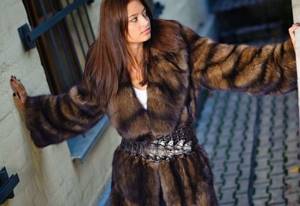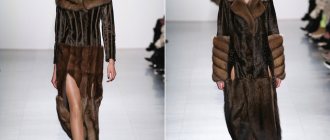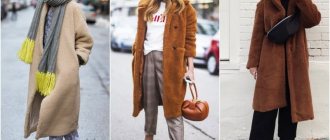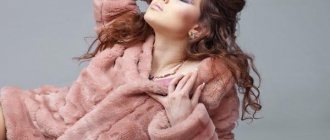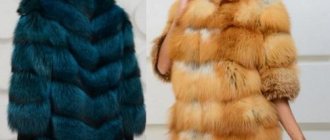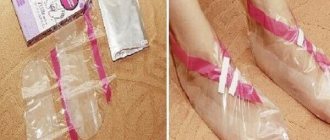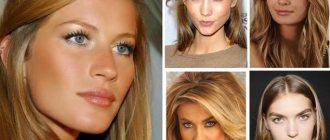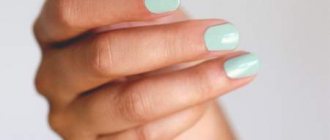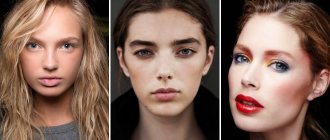Home / Fashion and style / Fur coats
The main value of a fur coat is natural fur. Delicate, fluffy, shimmering in the sun and durable. In addition to aesthetic characteristics, the material has a significant practical property - to warm. For thousands of years, wool products have been considered the best protection against the cold. Despite all the innovations in the outerwear industry, natural fur coats still hold the lead today.
There are hundreds of types of fur. The fur industry uses pelts from farmers, breeders, and hunters. Particularly valuable specimens are sold only at specialized auctions. The production of fur products is a real art. There are a huge number of varieties of natural fur coats. Designers boldly fantasize with the material, creating beautiful, warm models that demonstrate the femininity and status of the hostess.
Features and advantages of natural fur coats
Natural fur was and remains expensive. The complexity of producing natural products has led to the emergence of a huge number of fakes on the market - artificial models of mink, chinchilla, and sable. How to determine whether a fur coat is natural? High-quality material, regardless of origin, shines, is soft to the touch and, with slight deformation, quickly returns to its original state. These features of the original fur are difficult to imitate.
The main advantages of natural fur coats:
- Thermal properties. The product provides uniform heat over the entire area. Particularly warm fur coats made from mink, bear, and wolf.
- Individuality of models. Serial production in this case is impossible - the skins do not go into production in large quantities, in addition, each canvas has its own unique color.
- High-quality heat exchange. All artificial materials do not allow air to pass through well, while natural fur “breathes” - it warms without overheating the body.
- Water-repellent characteristics. For wet winters, a fur coat made from yak or beaver is recommended. Such products repel water particles without absorbing moisture.
- Wide selection of styles. The question of what types of fur coats there are is difficult to answer unambiguously. Fashion designers offer options for any body type, age and height.
- High strength. Some furs will last up to 20 years without losing their appearance.
- Symbol of social status. A sable fur coat, a model made from chinchilla and other rare materials is proof of a high financial level.
Everything you need to know about faux fur
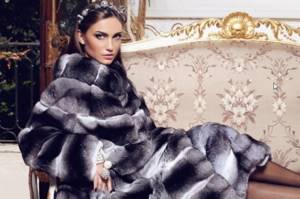
As we mentioned above, modern technologies make it possible to produce a worthy replacement for natural fur. Moreover, high-quality faux fur is quite difficult to distinguish from natural fur.
It has a number of advantages, but there are also quite a few disadvantages. Let's figure out what's what.
Benefits of faux fur
- No animals were harmed in its production.
- The cost of synthetic fur coats is several times less than natural ones. This happens for two reasons: the material itself is cheaper, and there is no need to be tricky with cutting.
- Faux fur coats are not damaged by moths.
- Faux fur products are much easier to care for.
Flaws
- Faux fur warms a little worse, primarily due to the breathability of the base.
- Faux fur loses its luster faster, and after a few years the fur coat no longer looks so chic.
- Faux fur is highly susceptible to electrification, which means static electricity attracts more dust. Yes, and it’s a dubious pleasure to “get shocked” after you’ve taken off your fur coat.
The cost and appearance of faux fur depends on the method by which it was made. Regardless of the manufacturing method, any fur consists of two main parts - the supporting base and the pile cover. There are currently four known types of faux fur:
- Woven or double-woven . This technology involves attaching fibers between two bases of the canvas (a kind of sandwich). After all the fibers are attached, they are further strengthened with an adhesive substance, and the base fabrics are cut along the entire plane.
- Knitted fur is made using circular or flat knitting machines. To do this, a pile is “tied” into each loop of the knitwear using a small knot.
- The tufting method involves stitching the load-bearing base using a tufting machine. As a result of this, pile loops are formed on the wrong side. Then the loops are cut.
- The adhesive method involves gluing thin fibers to the base. The villi can be of different lengths - this way the guard hair and down hairs are imitated.
It should be noted that trends in world fashion are highly dependent on public opinion. That is why not every couturier will risk including in his collection an outfit that includes natural fur, or consists entirely of it.
But honestly, we can’t say that faux fur coats look worse. You can see this for yourself by looking at the photos below.
Various prints, perfect fit. Besides... buying a faux fur coat without “all the money in the world” will allow you to change it after a few seasons to something more trendy.
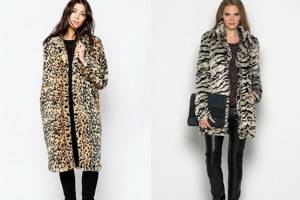
Finishing the topic of faux fur, we want to ask you: “Do you know why faux fur cannot be called eco-fur?” Seems logical, right? The animals remain whole; no one slaughters them for the purpose of getting their skins. It turns out everything is simple. In the 70s of the last century, Greek fur craftsmen achieved the adoption of a law prohibiting calling artificial fur “eco-fur”. And the basis for this law was the fact that the production of synthetics pollutes the environment, and synthetic materials themselves are a by-product of the oil industry.
The most popular furs
Types of fur coats differ not only in styles, but also in the material itself. The final cost, thermal characteristics, wear resistance and moisture resistance of the model depend on it. The documents for any natural product will indicate the place of origin of the fur. What are fur coats made from for the harshest winters? From the winter skins of animals living in the northern regions. If the documentation indicates that the skins were made in a warm country without cold winters, then, despite all the efforts of the breeders, such a product will not be warm enough.
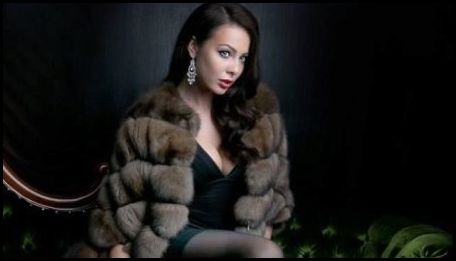
Wolf
The main feature of wool is its two-layer nature and increased density. The first layer is a hard guard hair that perfectly repels dirt and water particles. The second is a very thick undercoat that warms at extremely low temperatures.
The natural color of a wolf is unique, represented by a wide palette from black to light, white with a silver or brown tint. Zonal coloring makes the products original and without a complex style. Women's wolf fur coats are always extravagant; examples of interesting models are presented in the photo below.
Beaver
Beaver pelts are actively used for sewing outerwear and trimmings. Previously, fur was considered “male”, since uncut fur has an impressive weight. Today, processed beaver fabrics are used to make beautiful women's jackets with a delicate velvety structure and shiny surface. Beaver coats are among the most wear-resistant. The fur is thick, the spine is hard and long.
How to determine the natural color of a beaver? The natural tone of the beaver is only brown. Northern skins are dark, southern ones are slightly lighter. The color palette is not wide, which will allow you to quickly determine the fact of coloring.
Marten
The main feature of the marten is its almost complete similarity with the color of the sable. An excellent alternative for fashionistas who dream of an expensive sable fur coat, but do not have the funds for it. The quality of the hair is inferior to that of the expensive prototype. The fur is not as silky and soft.
Marten outerwear is completely hypoallergenic. Suitable for women with the most severe allergies to natural fur. The range of models is represented by products of different lengths and styles. Fashionable variations of fur coats are presented in the photo below.
Bear coat
The bear fur coat is plush and soft to the touch. The best protection against cold and strong wind. The guard hair is long, the half-fur is thick and durable. This material is not afraid of high humidity, dries quickly without loss of elasticity and silkiness. The products are wear-resistant and moisture-resistant - suitable for daily wear. A bear fur coat looks expensive and classy.
Chinchilla
The material has been highly praised by fur experts from all over the world due to the highest density of the pile, silky surface and minimal weight. Fur coats made from chinchillas have a unique color. The dark smoky color first turns into an azure steel color, then into a snow-white color.
Chinchilla is one of the most expensive fur coats. And this despite the low practical properties. The product will last 2-3 seasons, it is afraid of moisture, and will not warm you in severe frost.
Sable
Recognized fur "king". It is one of the most valuable on the fur market. The cost of one skin reaches up to $900. Due to its high price, sable is often used as a decoration.
Sable is not only a beautiful fur, but also practical. Thick, elastic undercoat, lush, silky guard hair of medium length provide the material with significant thermal characteristics. The fur has 7 natural shades from very light brass to almost black. The dark color in the palette is exclusive. It is extremely rare in nature, so it is very expensive. Light fur coats are more common on the market.
Mink and honorik
Mink are small animals that swim well and are adapted to an aquatic and terrestrial lifestyle. The fur is low, has a uniform shine, the pile rises evenly above the thick undercoat. Wool is one of the most delicate to the touch. Mink from North America and Canada is especially valuable. The color palette is wide, thanks to the work of breeders from all over the world. The darkest are chocolate and black. Black mink is exclusive, the second name is “black diamond” - it shimmers in several colors.
Honorik is an animal resulting from crossing a mink and a ferret. Unscrupulous sellers often use these skins to fake mink. The main difference is the color. A fur coat made from honorik has a heterogeneous pile - the guard hair is darker than the down. The mink is smaller than the ferret. Honorik is larger, therefore there are more skins.
Red fox and silver fox
The genus of foxes includes 10 species, each animal has its own unique and inimitable color. Common and marketable red fox skins. There are 20 natural colors of the common fox. The original color is bright red with black and white spots.

Among the rare shades, it should be noted - flames. The red color with a gray undercoat shimmers gorgeously in the sun, reminiscent of a fiery flame. There is such a fox in Kamchatka. It is one of the most expensive fox furs. The silver-black fox can be found in the northern regions. It's called silver fox fur. The skins have a gray down, white center guard hair and black tips. The value of the material is determined by the presence of a light shade - the lighter the middle, the more expensive the wool.
Arctic fox
Arctic fox fur is considered especially warm. Has thick and tall hair. Blue foxes are bred in captivity, while white foxes are hunted. Blue Arctic fox is hardy - service life is 12 seasons, white is less durable - 9 seasons. Particularly valuable breeds include the Norwegian Arctic fox, which has larger sizes, thick pile and high moisture-resistant characteristics. Products made from this fur are extremely durable.
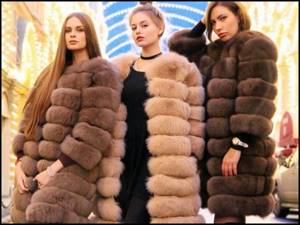
Rabbit
Rabbit fur coats are among the most affordable. The characteristics of the material depend on the breed of the animal, age, habitat and season of production. The heat-protective properties of long-haired fur are decent, but the strength is low. With active wear, the hair quickly breaks. The medium-length pile is durable and warm. Fur coats wear well at temperatures down to -15 degrees. It is better to buy an undyed rabbit, since treated fur loses wear resistance by 25%.
Yak fur
The yak is a large animal, weighing up to 850 kg. The coat is elegant, with very long guard hairs and dense, dense undercoat. Natural color is black-brown. The structure of the fur resembles human hair and is soft and pleasant to the touch. Yak fur coat is hypoallergenic and highly hygroscopic. Fits perfectly on any figure thanks to the elasticity of the material. Yak fur has medicinal properties - it improves blood circulation and reduces joint pain. Medical experts recommend these furs as a prevention of rheumatism.
Technologies for processing natural fur
Factory and hand-made skins are almost the same, but there are several points in terms of work.
Soak
The first stage of dressing is called soaking. As the name suggests, the essence is soaking the skins. This work is done to give the fur natural lightness and elasticity, and to remove the skins from preservation. The process consists of soaking the skin in water heated to a temperature of 40 ° C, and soaking in it for up to four days, it all depends on the type of animal. For 10 kg of fur, 80 liters of water are used.
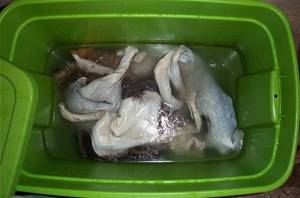
Soak
After 3 hours, you need to change the water, adding salt to the new solution, and repeat the soaking procedure, stirring the skins from time to time. After four days, they need to be squeezed out using a mechanical press.
Flesh
This procedure aims to remove all particles of meat and subcutaneous fat that remain from the carcass. The work is carried out on a special scouring machine, the main mechanism of which is a stainless steel shaft with screw knives mounted on it.
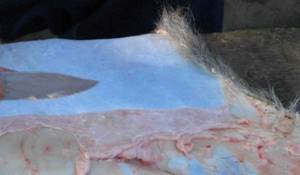
Flesh
The material is placed so that the knives move from the ridge to the sides of the skin and from the tail to the neck.
Pickling
This stage is needed to prevent the decomposition of the flesh as an organic object, soften the collagen compounds in the flesh and saturate the skin with the necessary acidity for the next process.
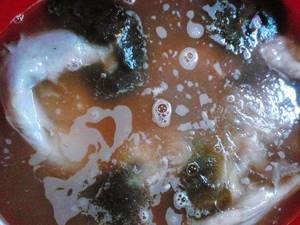
Pickling
The procedure is performed in special acidic liquids with salt. The most popular composition is a solution of salt and sulfuric acid. The liquid is prepared in the ratio: 10 g of sulfuric acid and 50 g of table salt per 1 liter of water. The solution is heated to 50 °C. Duration of soaking from 7 hours to 4 days.
Tanning
After tanning, the skin becomes soft and elastic and will not stretch or crack. As a tanning agent, you can use a strong infusion of oak or willow bark (0.5 liter of bark is added to 1 liter of warm water). Everything is mixed, brought to a boil and cooked for 20 minutes, then infused for a day. The tincture is decanted through a bandage and applied to the skin, which is then dried.
You might be interested in: Characteristics of double-thread lining fabric with lycra and its application

Tanning
Zhirovka
A special solution is prepared for this stage. In 1 liter of water you need to dissolve 200 g of fish oil and 50 drops. ammonia, cool the essence and add half a liter of water. These components are mixed and carefully applied to the skin, but so as not to stain the item. Next, the skins are dried at 25 °C.
Last processing
At the end, the fur coat is crushed using pumice or fine sandpaper, working it along the flesh from head to tail. At the end of the work, it is lifted and shaken off.
For your information! After all the manipulations done, the skin is finally dried within 24 hours, and it becomes ready for sewing the product.
Rare types of fur
What is in fashion today is not elite, expensive furs, but rare, unusual fur materials. Such products are produced for “gourmets” and are designed to attract attention and arouse interest. Unusual species include mole, possum and alpaca fur. The mole coat has a velvety, shiny coating with smooth fur. Beautiful rich black natural color gives interesting tints. The skins of the animals are valuable and rare due to their frequent, almost year-round molting. Products made from mole are an expensive pleasure; in addition to the complexity of the trade, experts note the capriciousness of fur during the sewing process.
The possum fur coat has already experienced a boom in popularity in the last century; today the wool has not left the category of exotic and remains popular among connoisseurs of natural furs. The material is beautiful with a silky shine. Exquisite colors: gray, golden, dark brown, black. The fur is light and very warm. The structure of the hair is similar to the fur of a polar bear - it is hollow, which allows it to retain heat well. An alpaca fur coat is a bright option for fur outerwear. The animal is a representative of the llama family. The coat is long, weightless and resembles plush. Despite their external decorative appearance, the models are quite warm and are recommended for European winters. Wool is not capricious and is not afraid of rain and wet snow. When wet, the hair curls into strong spirals, creating an interesting look. After natural drying and combing, the alpaca will become fluffy again. While mole coats are made to any length, llama coats are often shortened. Voluminous fur in an elongated style looks too massive and is not suitable for everyone.
Fashion trends
The fur industry does not stand still; fashion designers are always looking for new interesting furs or long-forgotten ones. Kangaroo fur coats appeared recently in our country, but were already popular 100 years ago. The fur is short, durable and exhibits decent thermal performance. Suitable for coloring; black and leopard print colors are popular.
What kind of fur are sheepskin coats made from?
Sheepskin coats are sewn mainly from the following types of skins.
Tuscany
These are young lambs of long-haired sheep, which are bred on special farms mainly in the south of the Iberian island in Spain. Thanks to its dense undercoat, long silky hairs, and well-polished outer surface, Tuscan lamb sheepskin is used for sewing very warm but luxurious items.
Merino
This is a skin from a fine-fleeced sheep called merino. Fur has a dense, durable pile, which is thin fibers with a developed structure. Thanks to this, merino skin has amazing healing properties and a good heat regulator. It absorbs excess moisture during sweating and generally has a beneficial effect on the body.
Enterfino
Varieties of this fur are obtained from the coarse-wool type of sheep. The fur, as the name implies, is stiffer and not the same as that of merino, and the flesh, on the contrary, is denser. Therefore, such coats are durable, but not very warm.
For your information! When creating outerwear from real fur, not only sheep skins are used, but also others.
Kangaroo
A rare skin, it is valued for its soft, thick, delicate, body-pleasant hair. It has a beautiful red color. Kangaroo items are sewn with the fur facing out.

Kangaroo
Such skins, decorated to resemble a leopard, look beautiful.
Important! Kangaroo leather is light, so people love to sew various sports shoes from it. It is convenient to exercise in it, as your legs will not get tired and sweat.
Marten
The marten is an animal that can be found mainly in the wild. Farmers have learned how to breed them, but this process is painstaking and long, and it is not always possible to obtain high-quality skins as a result. There are only a few of them in zoos, and hunting these animals is prohibited. Trapping is permitted at certain times and only in limited quantities.
Marten fur has several colors: dark blue, blue, gray, sand. In marten it is thick and silky, so the products are highly valued on the market.
Beaver
Beaver fur is produced only in Russia and Canada, each country using its own technology.
The Canadian beaver is more popular. The dressing of such skins is a difficult technological procedure when compared with the finishing of other skins. In order for the fur to be identical in some parameters of the fur (softness, elasticity), it must go through dozens of processing stages, which takes a lot of time.
You might be interested in this. Features of interlock: what are such fabrics made of?
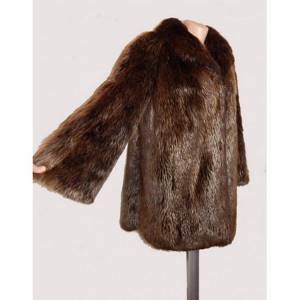
Canadian beaver
For your information! There are few beavers in Russia. The skins come in a variety of finishes because they come from hunters in small quantities.
How to choose
Before you go to the store, you should decide exactly what kind of fur the fur coat will be made of. Expensive breeds: sable, marten, lynx, arctic fox. Available are beaver, goat, mouton and rabbit. When choosing, it is important to consider the required thermal properties. If the product is purchased for harsh, long winters, then the warmest are mouton, nutria, mink, arctic fox and fox. A fur coat made from otter, nutria, and beaver is warm and not afraid of high humidity.
In the store you should carefully evaluate the quality of the workmanship. The core of undyed fur is always light and soft. If the fur coat is painted dark, the inside will be blue. Yellowness, roughness and dryness of the fur indicate the low quality of the fur coat.
Color solutions
Today, the fur industry is trying as hard as possible to preserve the natural colors of fur. Undyed wool wears better and looks beautiful. Among natural colors, brown, gray, blue and black are popular. At the peak of popularity, a sand-colored gopher fur coat is a bright and original natural color. Multi-level colors are trendy in the new season. Smoky tones, gray at the base and light at the end, look elegant and bright.
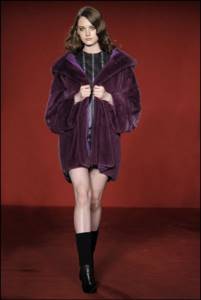
Silver fox fur coat - sophistication in the flesh
When we talk about silver fox, we mean the fur of a silver fox. This fur attracts with its splendor, thickness and length. If you look closely at its hair, you will notice that it is gray at the base, black at the tip, and white in the middle. Thanks to its “three-color” nature, it is prone to “games” and “shimmers,” which looks especially impressive against a snowy background.
Interesting articles:
- Groundhog fur
- Shub tour to Pyatigorsk
- Shub tour to China
Fashionable evening dresses fall-winter 2020-2021 Fashionable pareo summer 2020 About Louboutin, red soles and fashionable shoe brands Fashionable coats fall-winter 2017-2018 Review of the H&M spring-summer 2021 collection Kangaroo fur
What to wear with
When choosing a wardrobe, it is important to take into account the characteristics of fur. A yak fur coat is suitable for skirts and dresses no shorter than the fur coat itself. Pipe trousers or classic jeans will look harmonious with short fur coats. High heels or platform shoes are suitable. The polar bear fur coat is brutal. When creating a tandem with her, it is better to move away from the classic image. A harmonious combination will be provided by dark skinny jeans, boots with a rough platform or with wide heels. It is important to balance the silhouette correctly.
A classic style fur coat or column is universal. Suitable for formal trousers and skinny jeans. Shoes are better with high heels and only made from natural materials.
Stylish looks
Creating a fashionable look with a rare breed of wool is much easier than with the usual traditional materials. For example, a bear fur coat is itself the main exhibit. The main thing is to correctly emphasize the wildness of the product. Rough, high boots, jeans, no accessories, a retro-style bag and a stylish look is ready.
Bright emerald or red ombre yak fur will attract attention. When choosing clothes, it is important not to overdo it with colors. It is better to choose trousers, jeans, and a turtleneck in a calm color. Low-heeled or low-heeled shoes are allowed.
Beautiful, expensive, warm
Men's and women's fur coats made of natural fur have always been the objects of dreams for fashionistas and fashionistas around the world. Almost every season, similar products appear on the catwalks, and the first beauties try to appear in such an outfit at social events.
But children's models are no less relevant for our winters, because they are not only warm and comfortable. Babies look very beautiful in them. That is why the fur industry has recently been developing at an incredible pace.
